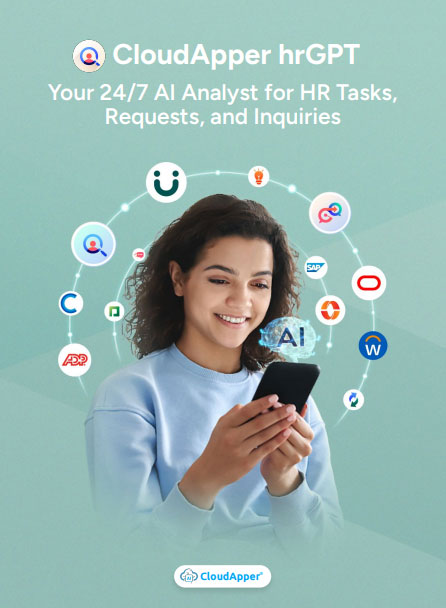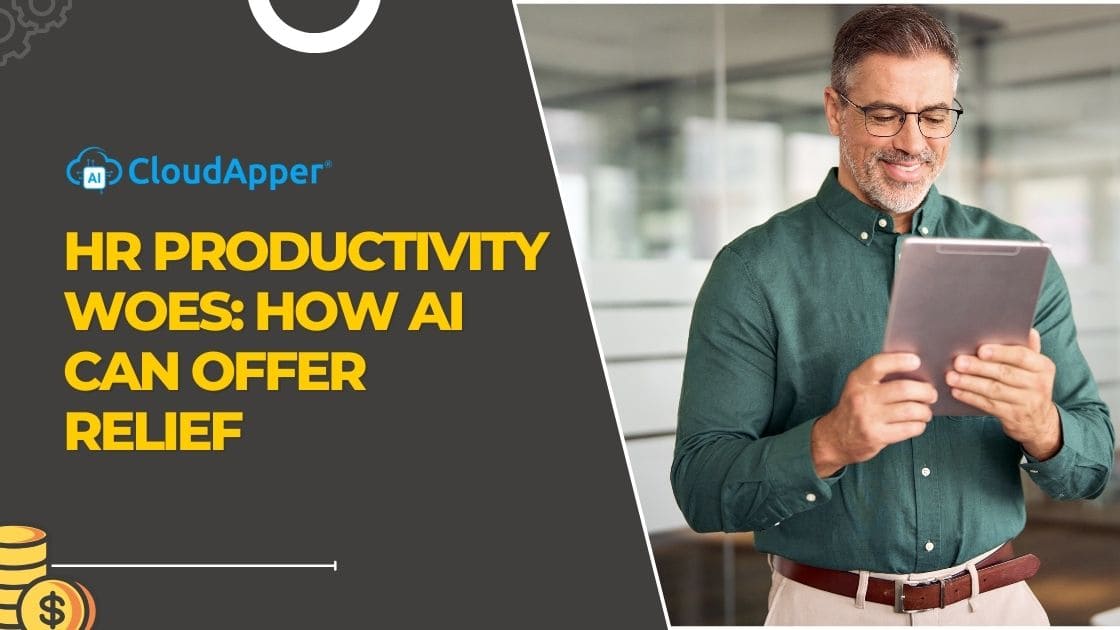AI is transforming HR productivity with CloudApper's hrGPT, AI TimeClock, and Text to Apply, simplifying processes, ensuring compliance, and engaging employees. Real-world examples illustrate how AI simplifies tasks. As AI matures, HR professionals can focus on strategic goals, and CloudApper's AI solutions offer real help to boost HR productivity, making it easier to meet today's business demands while ensuring effectiveness and efficiency. Invest in AI and watch HR productivity soar.
Table of Contents
Human resources (HR) practitioners encounter a constantly shifting set of difficulties due to the growing nature of the HR field. When it comes to managing an organization’s most important asset, the human resources department plays a crucial role. Human resources departments have a lot on their plates, from recruitment and onboarding to policy enforcement and employee morale. HR productivity has become an urgent concern for many businesses due to the increasing difficulty of HR-related jobs and the resulting need to maximize efficiency.
AI has arrived to completely transform the human resources industry. CloudApper’s hrGPT, AI TimeClock, and Text to Apply are just a few of the useful AI-powered solutions that have developed to address HR’s productivity issues. This article will discuss the ways in which artificial intelligence (AI) might improve HR productivity by streamlining HR procedures and reducing human error.
HR Productivity Challenges
Let’s take a look at some of the difficulties HR professionals encounter before diving into AI’s place in the field:
Administrative Overload: Human resources departments are frequently overburdened with mundane administrative activities, such as data input by hand. These responsibilities take up a considerable percentage of their time, leaving little space for more strategic HR endeavors.
Compliance Complexity: It is critical to adhere to all applicable labor laws, industry rules, and company policies. Compliance can be challenging, however, due to the dynamic nature of the regulatory landscape.
Time-Consuming Onboarding: Paperwork, documentation, and manual data collecting are all components of the typical onboarding process that add unnecessary time and effort to getting new workers up to speed and ready to work.
Employee Engagement: Paperwork, documentation, and manual data collecting are all components of the typical onboarding process that add unnecessary time and effort to getting new workers up to speed and ready to work.
Integration Challenges: Human resource (HR) departments in many companies employ several HCM solutions, which creates data silos and integration problems.
How AI Can Offer Relief
The solutions enabled by AI can help improve HR productivity in a number of ways:
Automation of Administrative Tasks: The administrative load of HR departments is lightened with the help of CloudApper AI TimeClock‘s accurate time monitoring, attendance management, and data collecting. This automation helps maintain reliable records by removing the possibility of human mistake during data entry.
Real-Time Compliance Assistance: Artificial intelligence assistant CloudApper hrGPT offers continuous regulatory direction. hrGPT reduces the likelihood of noncompliance by allowing HR departments to submit compliance documentation and HR rules as needed.
Streamlined Onboarding: AI for talent acquisition makes the hiring and application process streamlined. By eliminating paper and administrative delays, it enables new recruits to perform onboarding responsibilities using text messaging. Employee satisfaction and productivity both increase because of AI-driven onboarding.
Enhanced Employee Engagement: Solutions like hrGPT that are driven by AI interact with employees in real time, addressing their HR-related questions and concerns. Employee morale and productivity will both increase as a result of this.
Seamless Integration: CloudApper’s solutions are compatible with a wide variety of popular HCM software, including but not limited to: UKG, ADP, Oracle HCM, SAP SuccessFactors, Workday, Ceridian Dayforce, Paycom, BambooHR, PeopleSoft, and many more. The consistency of HR data is ensured by this integration.
Personalized HR Assistance: A tailored approach to HR help is made possible by AI assistants like hrGPT. Human resources experts’ time is freed up when workers use the AI assistant to get access to HR policies, obtain information, and address HR-related issues on their own.
AI in Action: Real-World Examples
Let’s take a look at some real-world instances to demonstrate the effect that AI has on HR output:
Example 1: Smart Time Tracking
Imagine a factory that uses CloudApper AI TimeClock to keep tabs on employee hours worked. Before the advent of AI, human resources employees documented clock-ins and clock-outs either manually or using expensive time capture devices, which opened the door to mistakes and increased deployment cost.
When using CloudApper AI TimeClock, staff members may clock in and out safely from any off the shelf tablet or iPad devices available in the market. To make the process even more secure and precise they can choose from several options for time capturing including Face ID, PINs, barcodes, and NFC. Not only does this automated method save the need for human data entry, but it also guarantees precise documentation and cost savings. All employee records are simply accessible using a self service feature and automatically gets synced with Payroll or HCM solution, saving HR professionals time and minimizing disagreements.
Example 2: Onboarding Efficiency
When expanding fast, it can be difficult for a software business to keep its onboarding process running smoothly as it adds new employees. Paper forms and document exchanges slowed down the onboarding process, thus modern procedures were implemented.
The application procedure has been simplified by using CloudApper Text to Apply. As part of the organization’s onboarding process, candidates scan a QR code or submit some basic information from a job posting web page to apply for a position. CloudApper hrGPT then engages with the candidate in natural language conversations to gather the necessary information, making the application process feel like a friendly chat. This method of automation streamlines the hiring and onboarding process and helps new hires hit the ground running.
The Future of HR Productivity
The value of AI to HR productivity is expected to grow as the field of AI matures. Human resource workers will be freed up to focus on strategic goals like employee engagement, talent development, and company growth thanks to the combination of AI assistants, automation, and seamless connection with HCM systems.
CloudApper hrGPT, CloudApper AI TimeClock, and CloudApper Text to Apply are just a few examples of AI-powered technologies that HR decision-makers should consider adopting to remain ahead of the curve. These AI solutions provide real help for HR’s productivity woes, allowing HR to keep up with the demands of today’s businesses without sacrificing effectiveness or efficiency.
Conclusion
The use of AI-driven solutions has made increasing HR productivity a realistic aim. Leading the pace in improving HR operations, lowering administrative hassles, guaranteeing compliance, and boosting employee engagement are CloudApper’s hrGPT, AI TimeClock, and Text to Apply. Human resources departments may benefit greatly from CloudApper AI’s ability to streamline processes and simplify procedures in the modern workplace. Invest in AI and see a dramatic increase in HR output.
What is CloudApper AI Platform?
CloudApper AI is an advanced platform that enables organizations to integrate AI into their existing enterprise systems effortlessly, without the need for technical expertise, costly development, or upgrading the underlying infrastructure. By transforming legacy systems into AI-capable solutions, CloudApper allows companies to harness the power of Generative AI quickly and efficiently. This approach has been successfully implemented with leading systems like UKG, Workday, Oracle, Paradox, Amazon AWS Bedrock and can be applied across various industries, helping businesses enhance productivity, automate processes, and gain deeper insights without the usual complexities. With CloudApper AI, you can start experiencing the transformative benefits of AI today. Learn More

CloudApper AI Solutions for HR



- Works with
- and more.
Similar Posts

How School Districts Are Solving Substitute Management Without Changing Their…

Best Practices for AI in Workforce Management: What Every HR…




















